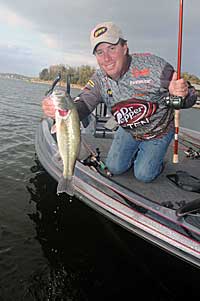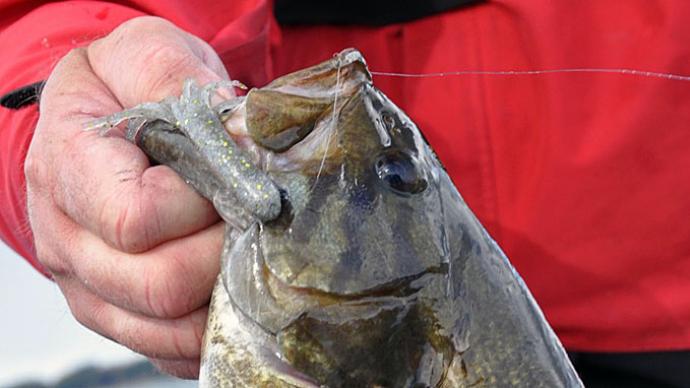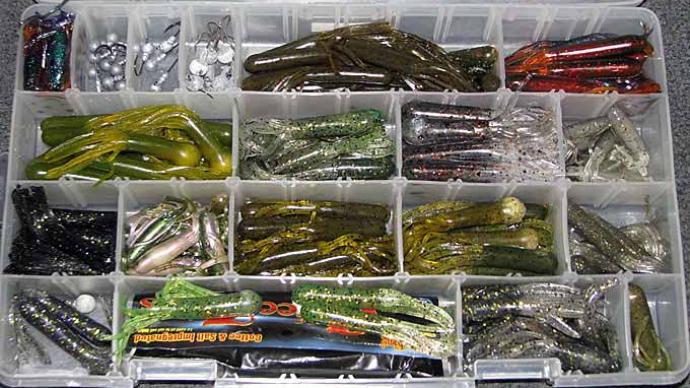
It looks like a Plain Jane when it’s out of the water, but dip it into a lake and turns into a sexy siren that beguiles bass with its seductive dance.
The drab-looking flipping tube's frilly skirt and hollow body cause quite a stir when the lure enters a bass’ water realm. “A jig or a beaver-type bait just falls straight down, but that tube glides more and spins and turns,” says FLW Tour pro Glenn Browne. “It is just much more erratic.”
When fishing big waters such as Lake Champlain and Erie for smallmouth bass, Browne relies on the smaller 3-inch tube baits, but his choice for catching largemouth bass is a 4-inch Gambler Flipp’n Tube. He favors the Gambler model because it is a heavy double-dipped tube with an inside layer in a chartreuse hue. His main color option is black neon/chartreuse, but he will opt for green pumpkin/chartreuse in clearer water.
Browne dotes on a flipping tube because he notes more than half of his winnings on the FLW trail result from him flipping a tube. He won the 2010 Ft. Loudoun/Tellico lakes tournament flipping his Gambler tube, and relied on the same bait last year to finish fifth in the Beaver Lake event.
“What I like about (the tube) is that I can fish it fast in terms of flipping,” says Browne. The Florida pro moves down a bank and targets whatever cover he can find, such as shoreline vegetation, wood (stumps, laydowns, and bushes), or boat docks. He also likes to flip the tube along bluffs where he stair-steps the lure down the ledges of the structure.
The three-time FLW winner Texas-rigs his tube with a 5/16- or 3/8-ounce VMC Tungsten Weight and a 5/0 Gamakatsu Extra Wide Gap Superline hook. If he is flipping thick bushes or trees, Browne opts for a 1/2-ounce weight since the heavier sinker can pull the tube through the limbs better than the lighter weights.
For most situations, Browne pegs his sinker with a bobber stop. If he wants his tube to fall with more action through the cover, he moves the bobber stop about 1/2 to 1 inch above the weight. “That makes it a little freer and still have it pegged so it will go down through the middle of a tree without fighting an unpegged weight that will slide a foot or two away,” says Browne.

His rigging method ensures a better hookset. Whereas many anglers run the hook point through both walls of the tube, Browne inserts the hook into the middle of the tube, runs the point through one wall, and skin hooks it back into the side. “I have an excellent hookup ratio that way,” he says. “I don’t have a problem losing fish on that.”
Browne pitches his tube with a 7 1/2-foot Team Lew’s Flippin’ Stick and a left-handed model Lew’s Tournament Pro baitcast reel with a 7.1:1 gear ratio. He prefers the high-speed reel because it allows him to quickly wind in the bait after working it in the cover so he can make more presentations throughout the day. The Florida pro opts for 20-pound Berkley Trilene 100 % Fluorocarbon, which gives the tube livelier action and prevents line twist better than heavier lines. “You have to pay attention when you have been around trees and retie your line periodically,” says Browne on using the lighter line for flipping. If he is fishing the tube in vegetation or flooded bushes, Browne selects 65-pound FireLine or Spiderwire for his flipping tactics.
Most of the time, Browne hops his tube, similar to the way Kentucky Lake anglers stroke a jig. He employs a series of hops and drops as he works the tube in or near the cover. “I don’t stroke it as violently (as the Kentucky Lake guys do), but I will move my rod from 10 o’clock to 11 or 11:30 and then let it go back down,” says Browne. “Sometimes, when I stroke it, I will reel down and stroke it again and pick up into a fish. “ The tournament veteran believes he loses less fish using fluorocarbon for this presentation because it is more forgiving than braid, which could cause too hard of a hook set when a fish engulfs the tube while he’s popping the rod.
The flipping tube produces best for Browne when he finds bass along the bank in shallow cover. He notes the prespawn is probably the prime time to flip the tube, although he has also caught fish on it during the spawn, early post-spawn, and fall.
BassResource may receive a portion of revenues if you make a purchase using a link above.




